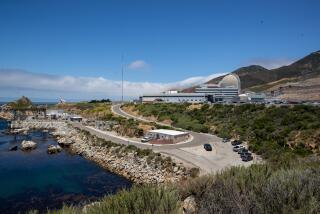U.S. Orders Closure of Hanford Nuclear Reactor
- Share via
YAKIMA, Wash. — The U.S. Department of Energy on Wednesday ordered the permanent shutdown of an experimental reactor at the Hanford nuclear reservation that has been without a mission for years.
A restart of the Fast Flux Test Facility is impractical, Energy Secretary Spencer Abraham said.
“This ends a seven-year scavenger hunt,” said Sen. Ron Wyden (D-Ore.), a longtime opponent of restarting the reactor. “I think it’s a huge plus for the region, and it will liberate dollars to focus on safety and cleanup and public health.”
Rep. Doc Hastings (R-Wash.), whose district includes Hanford, said the battle to save the reactor was one worth fighting.
“Of course, I’m deeply disappointed by DOE’s decision. We’ve worked too long and too hard not to be,” said Hastings. “We all hoped--frankly, we believed--that there was a private market for medical isotopes and we believed FFTF could help meet that need.”
The Bush administration had been studying since August the possibility that the reactor could be operated by private interests to make medical isotopes, which most often are used in radiation treatment for cancer. But the department concluded that the proposal presented costly operational and legal obstacles.
Though more than 20 years old, the FFTF is the Energy Department’s newest reactor, large and versatile because it was designed to research advanced forms of nuclear fuel for breeder reactors, which produce as much or more plutonium fuel than they consume.
The government scrapped its breeder reactor program in the 1980s after deciding it had misjudged the nation’s electricity needs.
The 400-megawatt FFTF became surplus and in 1992 was placed on standby. The nuclear fuel was removed from the core, but the sodium cooling system has been maintained to permit a possible restart.
The reactor has inspired an unusual degree of loyalty among people at Hanford and particularly among a group of cancer patients and their families, who wanted to see it used to make medical isotopes.
Last month, the Cancer Fighters Train Committee started a whistle-stop tour to draw attention to the plight of their favorite reactor.
Shutting down FFTF for good could take as long as five years and cost as much as $300 million.
It costs between $30 million and $40 million a year to maintain FFTF, where 230 people work.
Hanford is the nation’s most-contaminated nuclear site, a 560-square-mile reservation in south-central Washington where plutonium was made for four decades for nuclear weapons.
More to Read
Sign up for Essential California
The most important California stories and recommendations in your inbox every morning.
You may occasionally receive promotional content from the Los Angeles Times.












